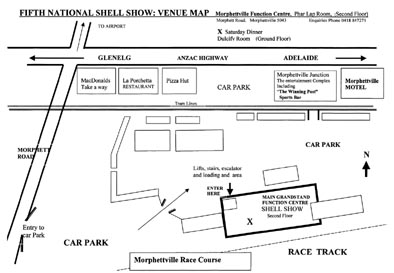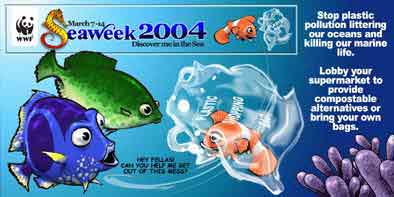
Marine Life Society of South Australia Inc.
Newsletter
March 2004
No. 308"understanding, enjoying & caring for our oceans"
March Meeting
Our speakers will be members Chris Hall and David Muirhead who will be showing more of their wonderful underwater slides. (However, keep an eye on the front page of our website as this may change at short notice.).
Contents
Catfish Sighting At Port Noarlunga Reef
Book Review
As Time Goes By------
Seaweek Postcard
Email from Tony Isaacson
David Muirhead Profile
MSSA National Shell Show
Contributors
This month our authors are Steve Reynolds, Philip Hall, Tony Isaacson, Geoff Mower and David Muirhead. Some contributors to Historical Articles have not been given as they were not credited in the appropriate newsletter.
MSSA National Shell Show
March 20/21st
If you can assist then please go to the last item for details.
Catfish Sighting At Port Noarlunga Reef
Last October I received a copy of the following email previously received by James Brook: -
"Hi James,
I’m not sure if this is of interest to you or Reefwatch, but I’ll let you know in case it is. On a night dive at (Port) Noarlunga Reef last night (16th) we saw an unusual fish (we thought was unusual anyway). At first we I thought it was a rock ling but it had more than two barbels (and I think more than four as well). I believe from my fishing book that it was an Estuary Catfish (Cnidoglanis macrocephalus) as the body was more rock ling shaped than the more stout bodied eel-tailed catfish (which is freshwater anyway). I just thought that this was an unusual sighting as (Port) Noarlunga reef is neither an estuary nor brackish water, which I believe they are found in. Also, according to the species location in my book, they are found in Queensland/Victoria and Western Australia. They’re probably very common here but I haven’t seen one before. Also it was about 1-1.2m, so quite big as well. We found it about 100-200m north of the jetty. If you can give me any feedback on whether this is an estuary catfish, and how common they are around here, I would appreciate it. Is there a database that this type of thing goes onto, on the website, or do I just email you the info? Hope this is of some use.
Cheers
Nick ( WHIT0604@flinders.edu.au )"
James wanted a response from me and so I sent him the following email reply: -
"Hi James,
I keep my own database of fish sightings at Port Noarlunga reef. I have recorded Estuary Catfish for the area. These are a marine species and they can be quite large. They occur in estuarine and coastal waters. They should have 8 barbels on their head. Max size is said to be just 91cm. Everything underwater looks 1/3 bigger i.e. 1.2m.
Steve"
Philip Hall reminded me of various articles published in our Newsletters and Journals so a later email read:
"Hi Nick,
Further to my last email re your catfish sighting, David Muirhead has written an article about a catfish sighting at Port Noarlunga. See the article "A Footbridge Too Far" in either our Dec. 2000 MLSSA Journal or our March 2003 Newsletter. Both publications can be viewed on our web site at http://www.mlssa.asn.au
Steve"
Steve Reynolds
Book Review
I have at last been given the opportunity to review a couple of books (booklets) hot off the press. David Muirhead loaned them to me.
They are two slim volumes published by ERA Publications, written by Robyn Opie and illustrated with superb pictures taken by David Muirhead. (You may recognise some but surely others should be in the MLSSA Photo Index!)
Cuttlebone is a simple guide to the physiology and life of the Cuttlefish. Part of the book concentrates on the cuttlebone and its uses by the cuttlefish and finally to humans. The end of the book stresses the environmental aspects of collecting the cuttlebone and ends with a Glossary. The booklet is aimed at the early years of schooling.
The second volume is titled "Sea Stars" and is a simple guide to Sea Stars, Brittlestars and related creatures. Its cover is shown here. Again it is aimed at the very young but the photographs really make it an attractive addition to any school (or home) library.
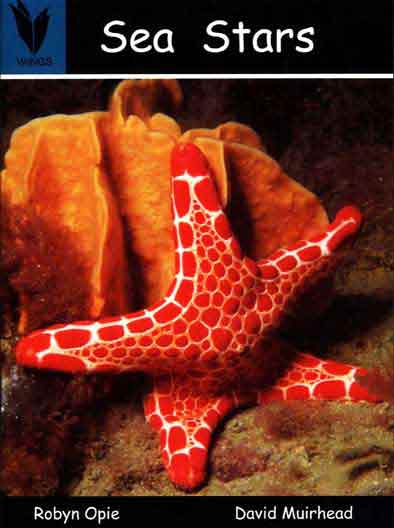
Philip Hall
As Time Goes By------
A selection of articles printed in previous Newsletters
5 years ago this month---March 1999
Blue-tailed Leatherjacket ~ Carrickalinga Sighting 18/1/99
I first commented on the regular occurrence of this large, distinctive leatherjacket in Adelaide metropolitan waters in the February ‘98 Newsletter. I later (April ‘98 Newsletter) reported a sighting slightly further south at Noarlunga Tyre Reef. Since then I have identified this species on Kangaroo Island's north coast (Western River Cove, 11/12/98 at approx. 15m depth - solitary large female) and Carrickalinga (13/1/99). The majority of fish sighted continue to be females, although I’ve added a photo of a male taken at Glenelg to the MLSSA Index. The latest encounter at Carrickalinga comprised three females all seen in the vicinity of a gutter with deep shelves along its sides, in only 6-7 metres depth, this being unusually shallow for this species in my experience. Although the three fish were within the same general area of reef and even within sight of each other for part of the time, they displayed no interest in each other and behaved seemingly independently of each other. On the few occasions where I have seen a male (Glenelg Barge 2/5/98 and 30/5/98, Glenelg Dredge 17/5/98 and Noarlunga Tyre Reef 15/3/98) there has always been an accompanying female, although the pair keep only a loose proximity when a diver approaches, and would for example each hide in a separate tyre complex rather than sharing one. A fellow diver living at Yankalilla, Greg Perry, reports seeing Blue-tailed Leatherjackets at Second Valley which would be to my knowledge the most southerly sighting on the Fleurieu Peninsula.
David Muirhead
10 years ago this month---March 1994
More about Stinkfish
Stinkfish belong to the Order Perciformes, Sub-order Callionymoidei and the Family CalIionymidae. Four species are listed in TM&FFSA. Why are they called stinkfish? TM&FFSA says that the Spotted Stinkfish, Callionymus calcaratus, "is said to be capable of giving off a most offensive odour!". At times, during my fish collecting days, I blamed a captured stinkfish for the deaths of other fish in a holding bucket. In August 1926 the Advertiser published the following account about the Common Stinkfish:-
"A fish was forwarded to the Museum, together with a letter stating that some Italians caught and cooked a similar fish a few days ago. The fishermen only tasted it, and spat it out, owing to the bitter flavour; they were bad all day, feeling sick. The seagulls would not touch the fish. Mr H. M. Hale of the Museum reports that the fish responsible for the trouble is the Stink Fish. He said, "In certain fishes, poisonous alkaloids are present in the body and are most developed during the spawning season. Such fish cause serious trouble if used as food." My "A dictionary of biology" says that "Alkaloids are a group of nitrogen-containing, basic organic compounds present in plants . . . . . . .possibly end-products of nitrogen metabolism. Of great importance because of their poisonous and medicinal properties . .".
15 years ago this month---March 1989
SEEN ANY GOOD TV SHOWS LATELY?
Remember the half-hour adventure series "Sea Hunt," made in the mid-sixties? As a kid I would be glued to the television every Sunday afternoon, watching the heroics of Lloyd Bridges as Mike Nelson, frogman par excellence, as he pitted his wits and diving skills against villains of all types. You, too, will be delighted to hear that the series has been revived and re-made for the modern generation.
The new "Sea Hunt" stars an aging Ron Ely (remember him as Tarzan,) as, believe it or not, Mike Nelson! Mike lives aboard his fully-equipped dive boat, the Sea Hunt with his nubile daughter, in a seclusion that would doubtless cause raised eyebrows if we didn’t know that this is a children’s show. The plots, now filmed in glorious living colour, are suitably up-dated. Last week we saw Mike brave gunmen (both bullet and spear) to plant a bugging device in a house used by drug-dealers. Now I bet Lloyd Bridges never even knew what heroin was (his female co-stars perhaps?) - he was always too busy ridding the world of commie agents for that!
Never mind, I can ignore all that. I can disregard the ghastly cliche that has Ron/Mike in an elegant ash-grey wet-suit, while the baddies are all in black. I can overlook the editing back and forth between Mike, and stock Al Giddings footage of sharks and morays. One point never fails to catch my attention, though. It is hard to take Mike seriously when he says "I was diving at 2 atmospheres," or "at this rate of ascent there was great risk of decompression sickness," when the surface can be clearly seen shimmering through the clear Bahamian waters, only 15 feet above his flippers. Funnily enough, I never noticed discrepancies like this in the old "Sea Hunt." Perhaps l’m just getting cynical in my old age.
Geoff Mower
20 years ago this month---March 1984
Damage to Seabed at Edithburgh Jetty
Bottle fossickers are reported to have dug up half of the seabed beneath Edithburgh Jetty on Yorke Peninsula. A large number of University experiments that have been in progress under the jetty for many years have now been destroyed. It is an offence to dig up the seabed without a permit from the Department of Fisheries. The illegal digging at Edithburgh has destroyed the study of growth rates of plants and animals living on the jetty pylons and the seabed. The damage done will certainly take many years to repair and could even be irretrievable.
Philip Hall

MLSSA member Tony Isaacson recently sent this informative email giving some more insights into his life in Queensland. A picture in our January Newsletter showed Tony with a new friend.
Hi Philip and Alex,
Hoping that this email finds you and your loved ones fit and well.
I do like the contact that your emails provide for I will never shake the wonderful years that have so defined who I am as a South Australian. Queenslanders are different and while I am adapting to the ways of what could so easily be described as an alien nation, I think that the values I’ve developed as a southerner (MEXICAN) more than hold their own against the overwhelmingly wealthy and the opportunistic welfare cultures of the "Coast".
I think that the diving in SA has more diversity and is more accessible for divers without boats. Summer is a time of frequent storms and the cane farmers are not the only ones responsible for some of the "rivers of shame". Caloundra Council is at least on the cutting edge of environmental management and has an environmental levy to keep its programs going.
This year I am at the Sunshine Coast Grammar School [http://www.scgs.qld.edu.au/] teaching marine units for year 10 in Society and Environment, year 9 Maths and year 10 Science. A Head of Department job is coming up and if I don't win that position, I’ll set about repeating what happened at Hallett Cove School.....it’s on the strength of the Hallett Cove story that they moved heaven and earth to appoint me despite the fact that I wasn't exactly what they were looking for in any of the advertised positions. At least now I can plan for the big picture stuff over the remainder of my career rather than watching out for any opportunities that come up in the state school system.
Seaweek kicked off the events at Hallett Cove and Underwater World [Mooloolabah] are really keen to work with us for Seaweek this year and to look at the development of a whole school approach to marine studies. We expect the TAFE and University to be equally proactive, as we are central to both of them. The kids are fabulous, discipline is not an issue, homework is set every night and extra curricular opportunities abound. With only five classes, 17 to 22 students per class four times a week....I’ve never had it so good.
I’ll have to enjoy these exceptional conditions while I can as the coast is expanding faster than any place in Australia and the infrastructures including school facilities are not keeping up with approved developments. Nambour sugar refinery just closed and I imagine a heap of new "canal lake"/Westlake type developments to bail out cash strapped families sitting on the coastal cane fields. Can you believe that they still burn the fields up here.....it’s a flurry of historical traditions that fly in the face of environmental awareness and responsibilities. Fortunately keel snakes and crows are doing their bit to keep cane toad numbers down.
Turtles don’t fair so well. Almost all of the turtles brought into Underwater World have floating disease cause by plastic ingestion and weight loss. Many survive but some are too far gone and stomach contents tell the all too familiar story from supermarket bags to discarded bait bags. Doggie do bags are biodegradable as we found out after keeping same in the car for a few weeks....they disintegrated on touch.
Hail this week trashed six hundred potted plants ready for our new garden. What didn't look like coleslaw in a pot was blown into the pool as a tossed salad. Eighty dents on the BMW next door and a few bits taken from our external render. We were lucky and the skyshows were spectacular.
Life remains in the fast lane and despite the fact that we've sold two houses to nearly purchase this one, we are doing major renovations this year if we can secure the services of a builder. Bricklayers are getting more than $1.00 per brick because of all the activity up here.
PICTURE
Hail on front lawn, Wednesday 28th Jan 2004.
Cheers for now, Tony
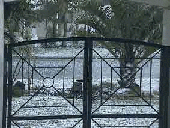
The "Southern Fisheries" article about Society member David Muirhead featured in the Summer 2002 issue. This issue is now firmly placed in the MLSSA library. The article takes up all of page 27 with the help of a black and white photo of David (seen here in colour). Chris Hall took David’s photo (with David’s camera?) from the steps of the Port Hughes jetty after our clean-up dive there in March 2002. It’s the same photo featured on the October page of our 2003 calendar. The cover of the 2003 calendar and two of David’s underwater photos are featured in full colour on page 26 of the magazine. The third picture is David’s stunning shot of a Short Boarfish, Parazanclistius hutchinsi under the Port Giles jetty in the early 1980s. It is slide number 1081 in our fish photo index and featured on the January 2003 calendar page in our 2002 calendar. The first picture is of a female Giant Cuttle, Sepia apama. It is slide number 2009 in our invertebrate photo index. Chris Hall also took the picture of the two Gorgonian Fans, Mopsella zimmeri featured on the front cover of the 2003 calendar. He had photographed the twin coral fans at the Aldinga Drop-off. It is slide number 2118 in our invertebrate photo index. Congratulations to David for having his life history featured in "Southern Fisheries" and for his photographic achievements from over 30 years of diving. Congratulations also to Chris Hall for having two of his photos featured in "Southern Fisheries" for David’s profile. The issue also featured the scuttling of HMAS Hobart in Yankalilla Bay, the Star of the Sea School’s Marine Discovery Centre and much more. SA Tourism recently released a promotional pamphlet about the Hobart artificial reef (Fleurieu Reef). A couple of David’s photos were used in the pamphlet.
Steve Reynolds
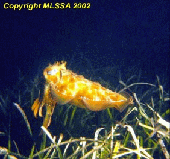
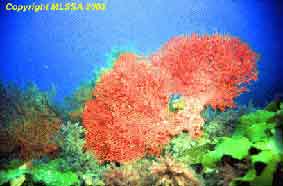
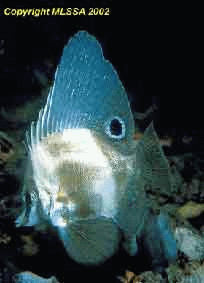
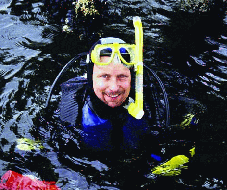
MLSSA is putting up a small display at the Shell Show.
Assistance is needed to:
1. Set up the display on Friday 19th March sometime
between 4.00pm and 6.00pm.
2. Tend the stand on Saturday 20th March
between 11.00am and 5.00pm.
3. Tend the stand on Sunday 21st March
between 9.00am and 5.00pm.
4. Dismantle the display on Sunday 21st March
after 5.00pm.
We will need members to assist with this display. The more volunteers we get the less time each has to spend at the display.
The benefit will be a free look at the Shell Show for those who assist so please contact me asap. - Philip Hall
